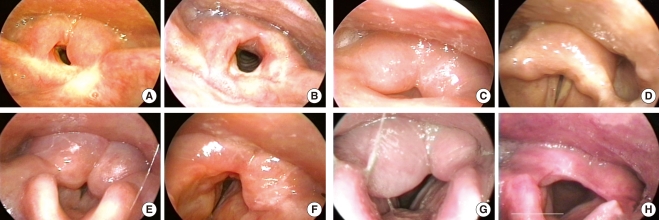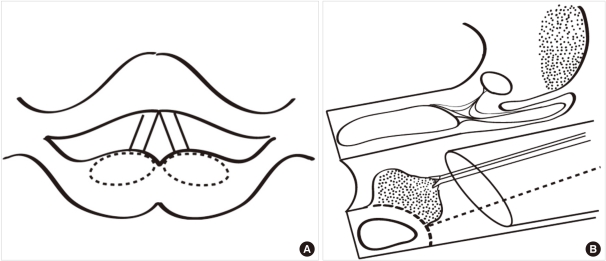Clin Exp Otorhinolaryngol.
2010 Dec;3(4):229-232. 10.3342/ceo.2010.3.4.229.
Transoral CO2 Laser Resection for Post-Radiation Arytenoid Edema
- Affiliations
-
- 1Department of Otolaryngology-Head and Neck Surgery, Kosin University Graduate School, Busan, Korea.
- 2Department of Otolaryngology-Head and Neck Surgery, Kosin University College of Medicine, Busan, Korea. kdlee@ns.kosinmed.or.kr
- KMID: 2049057
- DOI: http://doi.org/10.3342/ceo.2010.3.4.229
Abstract
- Arytenoid edema following radiation therapy of laryngeal cancer may persist and make careful inspection and evaluation of the larynx difficult. Moreover, it may have serious impacts on functions such as breathing, swallowing, speech and voice. Conservative management such as antibiotics and steroid may be attempted but may be ineffective in progressive and severe cases of edema. We present four cases of persistent postradiation arytenoid edema successfully treated with partial resection of the arytenoid mucosa using transoral CO2 laser.
Keyword
MeSH Terms
Figure
Reference
-
1. Ward PH, Calcaterra TC, Kagan AR. The enigma of post-radiation edema and recurrent or residual carcinoma of the larynx. Laryngoscope. 1975; 3. 85(3):522–529. PMID: 1121225.
Article2. Patterson JM, Hildreth A, Wilson JA. Measuring edema in irradiated head and neck cancer patients. Ann Otol Rhinol Laryngol. 2007; 8. 116(8):559–564. PMID: 17847721.
Article3. Ichimura K, Sugasawa M, Nibu K, Takasago E, Hasezawa K. The significance of arytenoid edema following radiotherapy of laryngeal carcinoma with respect to residual and recurrent tumour. Auris Nasus Larynx. 1997; 10. 24(4):391–397. PMID: 9352832.
Article4. Fu KK, Woodhouse RJ, Quivey JM, Phillips TL, Dedo HH. The significance of laryngeal edema following radiotherapy of carcinoma of the vocal cord. Cancer. 1982; 2. 15. 49(4):655–658. PMID: 7055780.
Article6. Wani MK, Yarber R, Hengesteg A, Rosen C, Woodson GE. Endoscopic laser medial arytenoidectomy versus total arytenoidectomy in the management of bilateral vocal fold paralysis. Ann Otol Rhinol Laryngol. 1996; 11. 105(11):857–862. PMID: 8916859.
Article
- Full Text Links
- Actions
-
Cited
- CITED
-
- Close
- Share
- Similar articles
-
- Transoral Laser Surgery for Laryngeal Cancer
- A Case of Transoral Excision Using CO2 Laser in Management of Lingual Thyroid with Oral Bleeding
- Transoral CO2 Laser Surgery of Supraglottic Cancer
- CO2 Laser Treatment of Dermatologic Lesions: Therapeutic Effects in the Cutaneous Pigmented and Vascular Lesions
- Comparative study between using co2-laser(ryj-II) and classic method in frenulotomy



